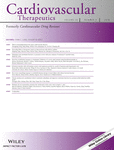The reverse remodeling response to sacubitril/valsartan therapy in heart failure with reduced ejection fraction
Funding information
Pieter Martens is supported by a doctoral fellowship by the Research Foundation - Flanders (FWO, grant-number: 1127917N). Pieter Martens, Pieter Vandervoort and Wilfried Mullens are researchers for the Limburg Clinical Research Program (LCRP) UHasselt-ZOL-Jessa, supported by the foundation Limburg Sterk Merk (LSM), Hasselt University, Ziekenhuis Oost-Limburg and Jessa Hospital.
Summary
Background
Major classes of medical therapy for heart failure with reduced ejection fraction (HFrEF) induce reverse remodeling. The revere remodeling response to sacubitril/valsartan remains unstudied.
Methods
We performed a single-center, prospective assessor-blinded study to determine the reverse remodeling response of sacubitril/valsartan therapy in HFrEF patients with a class I indication (New York heart Association [NYHA]-class II-IV, Left ventricular ejection fraction [LVEF] < 35%, optimal dose with Renin-Angiotensin-System-Blocker [RAS-blocker]). Doses of sacubitril/valsartan were optimized to individual tolerance. Echocardiographic images were assessed offline by 2 investigators blinded to both the clinical data and timing of echocardiograms.
Results
One-hundred-twenty-five HFrEF patients (66 ± 10 years) were prospectively included. The amount of RAS-blocker before and after switch to sacubitril/valsartan was similar(P = .290), indicating individual optimal dosing of sacubitril/valsartan. Over a median(IQR) follow-up of 118(77-160) days after initiation of sacubitril/valsartan, LVEF improved (29.6 ± 6% vs 34.8 ± 6%; P < .001) and Left ventricular end-systolic (LVESV) and end-diastolic volume (LVEDV) decreased (LVESV; 147 ± 57 mL vs 129 ± 55 mL; P < .001 and LVEDV; 206 ± 71 mL vs197 ± 72 mL; P = .027). Volumetric remodeling was associated with a reduction in the degree of mitral regurgitation (1.59 ± 1.0 vs 1.11 ± 0.8; P < .001; [scale from 0-4]). Metrics of diastolic function improved; including a drop in the E/A-wave ratio (1.75 ± 1.13 vs 1.38 ± 0.88; P = .002) and diastolic filling time (% of cycle length) prolonged (48 ± 9% vs 52 ± 1%; P = .005). The percent of patients with a restrictive mitral filling pattern dropped from 47% to 23% (P = .004). A dose-dependent effect was noted for changes in LVEF (P < .001) and LVESV (P = .031), with higher doses of sacubitril/valsartan leading to more reverse remodeling.
Conclusion
Switching therapy in eligible HFrEF patients from a RAS-blocker to sacubitril/valsartan induces beneficial reverse remodeling of both metrics of systolic as diastolic function.
CONFLICT OF INTEREST
The authors declare no conflict of interest.




